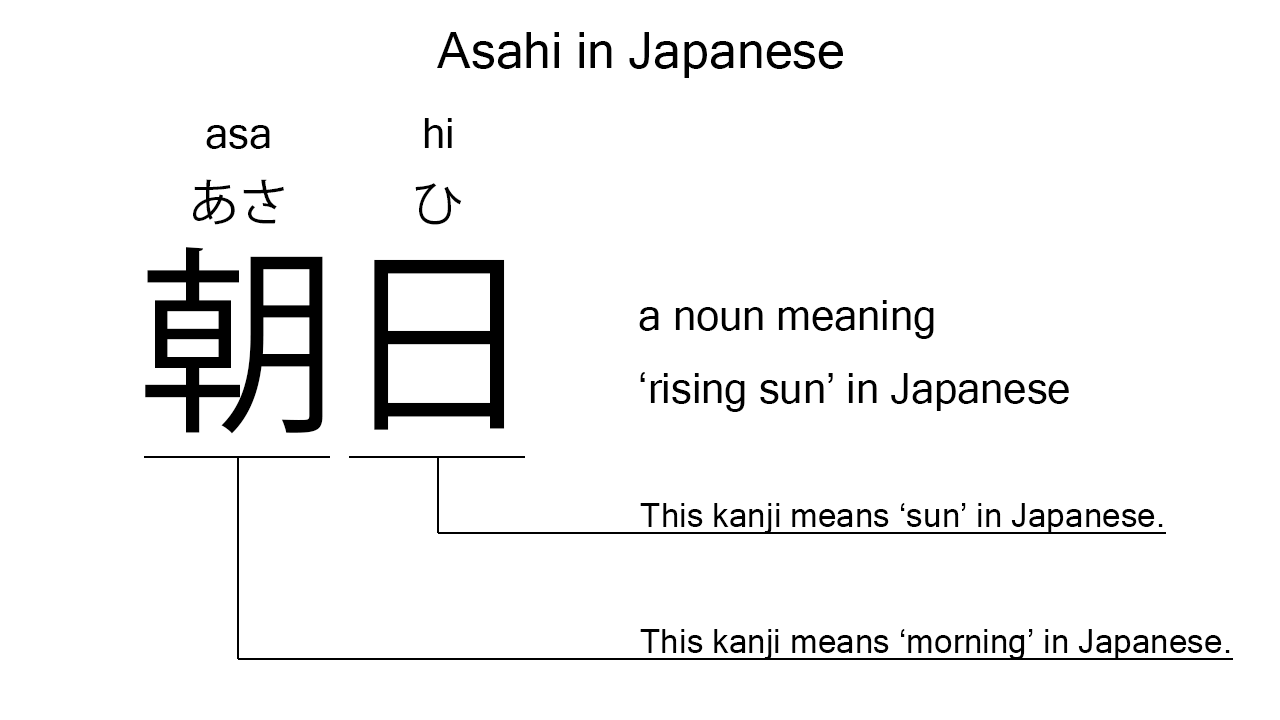What does “asahi” mean in Japanese?
Native speakers say “asahi” often to mean ‘rising sun’ in Japanese. Perhaps, some Japanese learners know this word as it is sometimes used in the Japanese culture. In this blog post, however, I will explain this word in detail based on its kanji expression. And also, I will explain how to use it through example sentences. My explanations would help Japanese learners understand “asahi” more clearly. Then, let’s get started!
Contents
Definition and meanings of “asahi”
Let me start with the definition and meanings of “asahi”.
- asahi – 朝日 (あさひ) : a noun meaning ‘rising sun’ or more specifically ‘sun rising in the morning’ in Japanese.
The definition and meanings are not that difficult, I think. To understand this noun more clearly, however, let me explain its kanji characters in detail, one by one.
What does “asahi” literally mean in Japanese?
The kanji expression of “asahi” consists of the following two kanji characters:
- 朝 : a kanji character used to mean ‘morning’ in Japanese.
- 日 : a kanji character used to mean ‘sun’, ‘sunlight’, or ‘day’ in Japanese.
These two kanji characters tell us that the formed noun literally means ‘the sun in the morning’ in Japanese. This literal interpretation is very close to the actual meanings.

When we meet new kanji expressions, we should check their kanji characters in detail to understand their meanings clearly and deeply. In many cases, kanji characters tell us a lot about the meanings of the expressions they form. Actually, here, we could get the better understanding of “asahi” through the detailed kanji check above.
So far, I’ve explained the definition and meanings of “asahi” together with its kanji characters. Then, let me explain how to use it through the example sentences below.
Example #1: how to use “asahi”
asahi ga totemo utsukushikat ta – 朝日がとても美しかった (あさひがとてもうつくしかった)
The sun rising in the morning was very beautiful.
Below are the new words used in the example sentence.
- ga – が : a case particle used to make the subject word or the object word in a sentence. In the example, this is used after “asahi” to make the subject in the sentence.
- totemo – とても : an adverb of degree meaning ‘very’, ‘much’, ‘so’, or such in Japanese. In the example, this works in front of “utsukushikat ta” to emphasize its meaning.
- utsukushikat – 美しかっ (うつくしかっ) : one conjugation of the i-adjective, “utsukushii“, which means ‘beautiful’ in Japanese. In the example, it has been conjugated for the better connection with its following word.
- ta – た : an auxiliary verb used after a verb, adjective, or auxiliary verb to make its past tense form. Probably, this is well known as a part of Japanese ta form. In the example, this is used after “utsukushikat” to make its past tense form, “utsukushikat ta”.
This is a typical usage of “asahi”. In this example, it works together with “ga” to become the subject in the sentence and means ‘the sun rising in the morning’ in Japanese.
Example #2: another usage of “asahi”
kanojo wa asahi no shashin wo tot ta – 彼女は朝日の写真を撮った (かのじょはあさひのしゃしんをとった)
She took a picture of the rising sun.
Below are the new words used in the example sentence.
- kanojo – 彼女 (かのじょ) : a pronoun meaning ‘she’ in Japanese.
- wa – は : a binding particle working as a case marker or topic marker. In the example, this works after “kanojo” to make the subject in the sentence.
- no – の : a case particle used to join two nouns. Normally, the first one can work as a modifier to describe the second. In the example, this is used to join “asahi” and “shashin”. The formed phrase literally means ‘a picture of the rising sun’ in Japanese. Word orders in Japanese and English are different, but the role of this case particle is similar to that of the English preposition, “of”.
- shashin – 写真 (しゃしん) : a noun meaning ‘picture’ or ‘photo’ in Japanese. This can also work as plural. Learn more about Japanese plural.
- wo – を : a case particle used to make the object word in a sentence. In the example, this is used after “asahi no shashin” to make the object in the sentence.
- tot – 撮っ (とっ) : one conjugation of the verb, “toru”, which means ‘to take’ in Japanese. In the example, it has been conjugated for the better connection with its following word.
This is another typical usage of “asahi”. In this example, it works as a part of the object in the sentence. When we want to refer to the sun rising in the morning, anyway, this Japanese noun is always a very good option.
Summary
In this blog post, I’ve explained the definition and meanings of “asahi” in detail based on its kanji expression. And also, I’ve explained how to use it through the example sentences. Let me summarize them as follows.
- asahi – 朝日 (あさひ) : a noun meaning ‘rising sun’ or more specifically ‘sun rising in the morning’ in Japanese. These two kanji characters literally mean ‘the sun in the morning’ in Japanese. This literal interpretation is very close to the actual meanings.
Hope my explanations are understandable and helpful for Japanese learners.